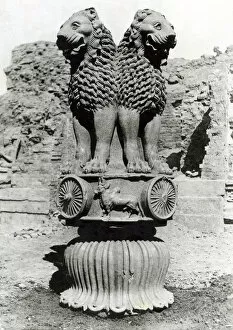Asoka Collection
Asoka, the Great Emperor of India, left an indelible mark on history with his reign that spanned from 268 to 232 BC
For sale as Licensed Images
Choose your image, Select your licence and Download the media
Asoka, the Great Emperor of India, left an indelible mark on history with his reign that spanned from 268 to 232 BC. His legacy is evident in the remnants of his palace, as seen in Fa Hisen's lithograph from 407 AD. The ruins stand as a testament to Asoka's grandeur and power. In 261 BC, Asoka's envoy declared peace, showcasing his commitment to diplomacy and harmony. This lithograph captures a pivotal moment in history when Asoka sought to unite his empire through peaceful means. A portrait further reveals the majesty and wisdom that characterized this remarkable ruler. The lithograph brings him to life, allowing us a glimpse into the face behind the legend. The Lion Pillar of Emperor Ashoka stands tall even today, serving as a symbol of strength and resilience. Dating back to c. 264-223 BC, this photo showcases its intricate details and craftsmanship. Copies of stone inscriptions by Emperor Ashoka provide valuable insights into his governance and beliefs. These artifacts offer glimpses into ancient edicts that shaped society during his rule. At Monkey Pond lies another Lion Pillar erected by Emperor Ashoka himself. Its presence amidst nature highlights both its historical significance and harmonious integration with the environment. Asokas' missionaries were instrumental in spreading Buddhism across Asia during their time. A lithograph depicting them setting up an edict pillar at Lauriya Nandangarh in 244 BC showcases their dedication towards propagating their faith. The detailed engravings on pillars like those found at Mauryan reveal not only artistic mastery but also serve as historical records documenting laws enacted by Emperor Ashoka for societal welfare. Moving forward in time, we encounter the ruins of Kotla Firuz Shah citadel founded centuries later by Firuz Shah Tughluq (1351-88). Although unrelated directly to Asoka's era, it serves as a reminder of the lasting impact he had on subsequent rulers.
















